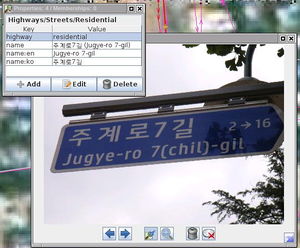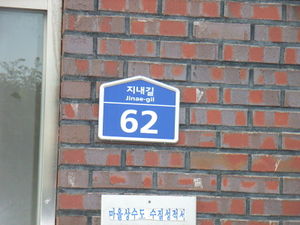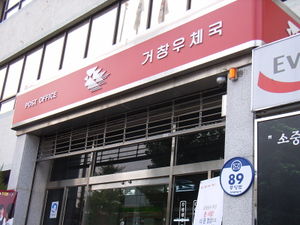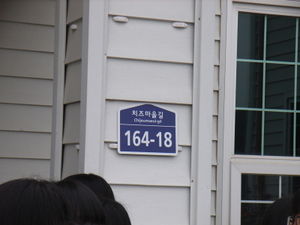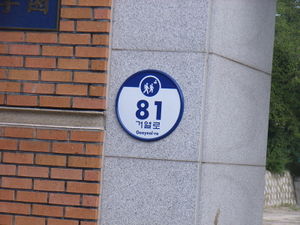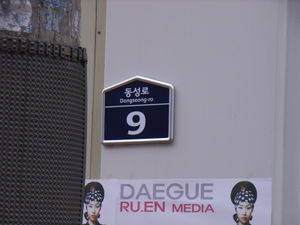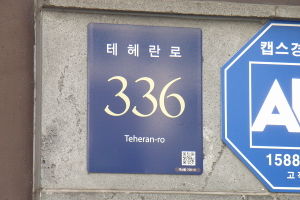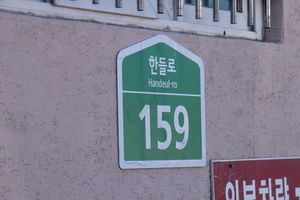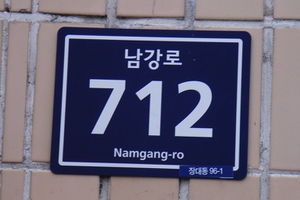South Korea Streetsigns
In 2009 the Korean government introduced a new street naming scheme. Across the country new street signs were installed and new house number plaques were distributed. See Korea Streetsigns history for a discussion of the history of Korean streetsigns and addresses. You will find that most name tags in Korea are still tagged with Hangeul and English (in brackets) the name tag. The convention recently changed, please follow these rules now and help the manual transition.
Street names
Here's how I enter the information from the street signs. As you can see, there are four tags filled in:
| Tag (key=value) | Description |
|---|---|
| highway=residential | The first one is the type of street. In Korea, virtually every kind of street is now named. In this example it was a residential street, but it could be a major road or motorway! |
| name=주계로7길 | This is the 'general' name of the street in Hangeul. |
| name:en=Jugye-ro 7-gil | The English name of the street if known. In the English name, do not include any number transliteration (in the example "chil" for 7 is omitted). The reason for this is because it is not used on all signs, so we should be consistent and omit it. |
| name:ko=주계로7길 | The Korean name of the street, in Hangeul. |
| name:ko-Latn=Jugyerochilgil | If you know the Hangeul Romanisation, add it using this tag. Use the appropriate romanisation rules depending on if the element is in the North or the South. |
Note: Street names sometimes do not follow a street in a straight line. It is possible for a street name to go around a corner rather that along the entire street or road.
This convention should be used for most objects in the OSM data for Korea. Please help with the transition.
Addresses
The new street address signs have two forms: a 'house shaped' blue rectangle with a triangular top for most homes and businesses, and a circular sign with blue writing for public buildings. The address number may contain a hyphen.
Homes and businesses
These signs generally have the address number in large white numerals and the street name in Hangeul and English on a blue background. Public buildings often have a circular sign, and some color and shape variants can be found.
Public buildings
These signs, on schools, libraries, post offices etc., have the address number in large blue numerals on a white background with the street name in Hangeul and English and a circular logo to indicate the type of building.
How to map
The Karlsruhe addressing schema works well in Korea with the new addressing scheme.
- Enter the address number (including hyphens if present) into addr:housenumber=*
- Enter the street name (in Hangul only) into addr:street=*
- Ensure that the street is recorded on the map nearby as a way with name:en=* and name:ko=* tags. Ensure that the Korean and English names for the way match the Korean and English names on the address sign.
It is not necessary to add the English version of the street name into any addr=* tag. Software can match the Korean street name from addr:street=* with the name=* tags from nearby ways to get the English.
Examples
| Address sign | Tags (key=value) |
|---|---|
| addr:housenumber=89 addr:street=중앙로 | |
| addr:housenumber=62 addr:street=지내길 | |
| addr:housenumber=164-18 addr:street=치즈마을길 | |
| addr:housenumber=81 addr:street=거열로 | |
| addr:housenumber=9 addr:street=동성로 | |
| addr:housenumber=336 addr:street=테헤란로 A square sign in Seoul. | |
| addr:housenumber=159 addr:street=한들로 A green background in Hamyang County. | |
| addr:housenumber=712 addr:street=남강로 A rectangular sign in Seoul. |
Links
official government site regarding the new addressing scheme
